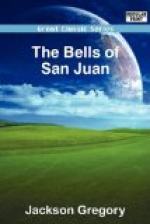Out on the desert a man might stop and listen, forming his surmise as the sounds surged to meet him through the heat and silence. He might smile, if he knew San Juan, as he caught the jubilant message tapped swiftly out of the bronze bell which had come, men said, with Coronado; he might sigh at the lugubrious, slow-swelling voice of the big bell which had come hitherward long ago with the retinue of Marco de Niza, wondering what old friend or enemy, perchance, had at last closed his ears to all of Ignacio Chavez’s music. Or, at a sudden fury of clanging, the man far out on the desert might hurry on, goading his burro impatiently, to know what great event had occurred in the old adobe town of San Juan.
It is three hundred and fifty years and more since the six bells of San Juan came into the new world to toll across that land of quiet mystery which is the southwest. It is a hundred years since an all-but-forgotten priest, Francisco Calderon, found them in various devastated mission churches, assembled them, and set them chiming in the old garden. There, among the pear-trees and olives and yellow roses, they still cast their shadows in sun and moonlight, in silence, and in echoing chimes.
CHAPTER I
THE BELLS RING
Ignacio Chavez, Mexican that he styled himself, Indian that the community deemed him, or “breed” of badly mixed blood that he probably was, made his loitering way along the street toward the Mission. A thin, yellowish-brown cigarita dangling from his lips, his wide, dilapidated conical hat tilted to the left side of his head in a listless sort of concession to the westering sun, he was, as was customary with him, utterly at peace. Ten minutes ago he had had twenty cents; two minutes after the acquisition of his elusive wealth he had exchanged the two dimes for whiskey at the Casa Blanca; the remaining eight minutes of the ten he required to make his way, as he naively put it, “between hell and heaven.”
For from a corner of the peaceful old Mission garden at one end of the long street one might catch a glimpse of the Casa Blanca at the other end sprawling in the sun; between the two sturdy walled buildings had the town strung itself as it grew. As old a relic as the church itself was La Casa Blanca, and since San Juan could remember, in all matters antipodal to the religious calm of the padres’ monument. Deep-shaded doorways let into the three-feet-thick earthen walls, waxed floors, green tables, and bar and cool looking-glasses . . . a place which invited, lured, held, and frequently enough finally damned.




